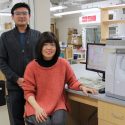U.S. chemistry forecast: ‘Partly cloudy, chance of showers’
A report released this month by the National Academy of Sciences concludes that although the United States currently leads the world in most aspects of chemistry research, increasing international competition makes that position far from secure.
A panel of chemistry experts, chaired by UW–Madison chemistry professor emeritus Charles Casey, detailed how the United States stacks up against other countries in chemistry research. Although current U.S. performance is strong, the panel concludes that such a lead is tenuous in the face of flattening chemistry research budgets and declining numbers of American students pursuing chemistry doctoral degrees.

According to a report released this month by the National Research Council, foreign citizens currently earn more than 40 percent of the chemistry doctorates awarded in the United States. UW–Madison chemist Charles Casey, chair of the national panel, warns that declining American interest in science and technology may weaken U.S. research competitiveness against Europe and Asia.
Failure to maintain an emphasis on science may have expensive economic consequences in the United States, Casey says. “Investing in science is key to innovation, which is key to making jobs.” He sums up the panel’s forecast of U.S. chemistry as “partly cloudy, with a chance of showers.”
The report documents U.S. strength in several measures of quality, including highly cited research papers and individual researchers’ repute among their peers. However, Casey says, while U.S. performance in areas such as scholarly publications and Ph.D. degrees awarded is traditionally high — in some measures the highest in the world of any single country — the numbers have leveled in recent decades. For example, U.S. universities have awarded approximately 2,000 chemistry Ph.D. degrees every year since 1970.
In contrast, productivity is on the rise in many other countries, including parts of Western Europe and relatively new entrants into the field such as China and India, meaning that the United States’ share of the world’s chemistry pie is shrinking. During the past decade, the percentage of worldwide chemistry research papers published by U.S. scientists dropped from 23 percent to only 19 percent, while work published by Asian countries excluding Japan tripled to a level nearly equal that of the United States.
Much of the U.S. strength in scientific research relies upon a large population of foreign students and workers. According to the report, foreign citizens currently earn more than 40 percent of the chemistry doctorates awarded in this country and hold more than a third of all U.S. science and engineering jobs.
A consideration for the future, Casey says, is whether the U.S. can continue to recruit and retain foreign students and researchers even as resources plateau here but increase in countries such as China and India.
Casey also cites the importance of attracting more American students into scientific fields. The panel reported that in 2002, for example, only 6 percent of American 24-year-olds held degrees in science and engineering fields, in contrast to 17 percent in Taiwan in 2003.
Casey emphasizes the timeliness of the issues raised by this report, especially in light of current governmental policies such as the American Competitiveness Initiative, announced by the Bush Administration in 2006, which proposes increased funding for research and for improving K-12 math and science education.



